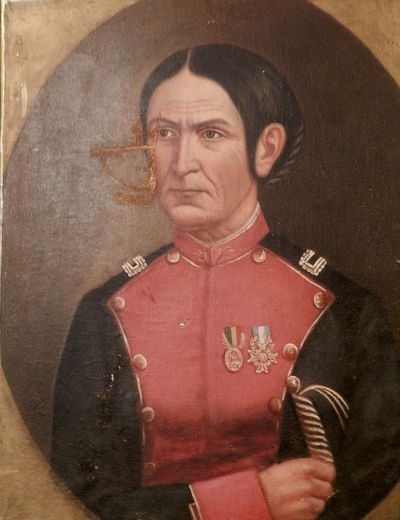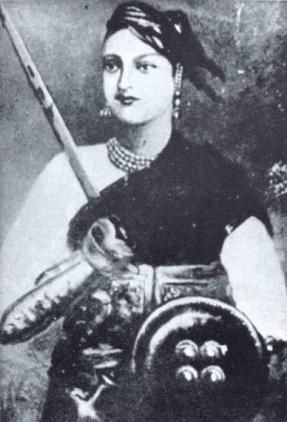Women Warriors: The Hidden History of Female Combat Heroes
In the records of what shaped the world we live in today, men have gotten all the glory—but these women changed the course of history too.


With the U.S. only recently allowing women to fight in combat, you have to wonder what ever gave legislators the impression that only males can defend their country (and cis males, at that). Has the past taught us nothing? Women have pretty much always been defenders of land, home, and people—and many have done so with military skill and bravado to rival any man's.
Here, a look at some of the amazingly bold women who served their country with impressive physical might—even as early as 1200 BC.
Laskarina Bouboulina (1771 - 1825)

A Greek naval commander, Laskarina Bouboulina was born—quite literally—in a prison in Constantinople. Her father, a captain from Hydra, was a rebel against the Ottoman Empire, and her mother gave birth while visiting him. He died soon thereafter, and they returned to Hydra, only later to move to the nearby island of Spetses, where her mother remarried.
She herself married twice, the second time to Dimitrios Bouboulis, a wealthy shipowner and captain—it was from him that she took her name. He died after coming up against Algerian pirates in 1811, and Bouboulina—at the age of 40—took over his business, constructing four more ships, including a huge warship Agamemnon. In 1816, Ottomans tried to take her property away, claiming that her husband had fought against them and in favor of the Russians. She appealed to the Russian ambassador, who sent her away to live safely for some time, and allegedly also appealed to the mother of the Sultan of the Ottoman Empire, who reportedly ended up telling her son to leave Bouboulina alone. (Even sultans need to listen to their mothers.)
Bouboulina returned to Spetses, where she then (allegedly) joined the Filiki Etaireia, an underground Greek revolutionary group ready to lead rebellion against the Ottomans. She provided arms and ammunition at her own expense, and, according to some, on March 13, 1821, just 12 days before the official start of the War of Independence, she was the first to raise a revolutionary flag—her own Greek flag—on her ship, the Agamemnon. Bouboulina sailed with eight ships to Nafplion and began a naval blockade. She later witnessed the fall of Tripolis and, thus, the creation of a new Greek state. She was arrested twice during the civil war of 1824 and expelled back to Spetses. There, she lived for the rest of her life, without her fortune. She was shot and died in 1825 in a dispute between families.
After her death, Emperor Alexander I of Russia granted Bouboulina the honorary rank of Admiral of the Russian Navy. That made her—until very recently—the only woman in naval history to hold that distinction. Coins carried her likeness, streets her name, and films her story.
The Trung Sisters (Circa AD 12 - AD 43)
Talk about badasses. The Trungs—Trưng Trắc (徵側) and Trưng Nhị (徵貳)—gathered an army of 80,000 people to help drive the Chinese from Vietnam in AD 40, the first Chinese domination of Vietnam. Born in Northern Vietnam in Giao Chi, the history of the sisters is brief, but we do know that they led the uprising to defeat Chinese forces. Their father was a prefect of Mê Linh, meaning they grew up learning the martial arts. They studied the art of warfare along with actual, physical fighting skills. During this time, women could inherit land through their mother's line *and* become political leaders (this, like many things, would change over time).
Get exclusive access to fashion and beauty trends, hot-off-the-press celebrity news, and more.

One of the Trung sisters—Trắc—fell in love and married another lord, Thi Sách. After Chinese rule became more and more restrictive, it is said that Thi Sách stood up to Chinese officials and was promptly executed as an example of what happens to those who dare to defy. This is when the Trung sisters began their campaign against the Chinese, leading nearly 80,000 warriors (and naming many women generals). For three years, they were able to keep their country relatively free of Han rule through sheer force. In 43 AD, their troops were badly defeated and they were outnumbered. According to Chinese writings, they were decapitated. According to Vietnamese? They either committed suicide or disappeared into the sky. In any case, they are revered as models of women's strength, with temples built in their honor.
Boudica (Circa 30 AD - 61 AD)

This Celtic warrior queen led a rebellion against Roman rule in ancient Britain. Not much is known about her early other than what's written by Roman scholars, but she was said to be born into an elite family, later marrying Prasutagas, king of the Iceni tribe of modern-day East Anglia. He was left to rule as an ally of Rome, an unusual move at the time, but when he died this was ignored, his land taken, and his family publicly humiliated—Boudica was flogged while soldiers raped her two daughters.
Roman scholar Tacitus recorded Boudicca's promise of vengeance after this: "Nothing is safe from Roman pride and arrogance. They will deface the sacred and will deflower our virgins. Win the battle or perish—that is what I, a woman, will do."
Like many women of her time, Boudica was trained in the art of battle—so fighting was as natural to her as anyone else. In AD 60 or 61, when the Roman governor Gaius Suetonius Paulinus was campaigning on the island of Anglesey off the northwest coast of Wales, Boudica led the Iceni and others in revolt. They destroyed Camulodunum, a Roman settlement, and killed all the inhabitants. The Roman governor heard about the revolt and rushed back—but not before an estimated 70,000 to 80,000 Romans and pro-Roman Britons were killed in the three cities by warriors led by Boudica.
"Win the battle or perish—that is what I, a woman, will do."
The Romans eventually won against the Britons, despite being outnumbered, and it's said that Boudica was either killed after being captured or committed suicide to prevent herself from being captured—texts differ. But Boudica came to be exalted as a hero, particularly during the Victorian Era, and seen as an icon of justice and bravery.
Juana Azurduy de Padilla (1781 - 1862)

Born in Bolivia with Spanish and Indigenous blood, the mestiza warrior wanted, at first, to become a nun. She joined the convent at age 11, but was kicked out at 17 due to her rebellious nature. She married Manuel Ascencio Padilla, who shared her love of the indigenous people of Bolivia. She and her husband then joined the Chuquisaca Revolution, a rebellion against the governor of Chuquisaca, now Sucre, the capital of Bolivia. The rebellion is often seen as the beginning of the Spanish-American wars for independence and is known in Bolivia as primer grito libertario, or "the first Libertarian scream." She continued to fight in many militia groups against those trying to seize South American land.
In 1816, she organized 30 cavalry—among them many women—to attack the La Hera Spanish forces and take their weapons. That same year she helped to capture the enemy and take hold of Cerro Rico, a mountain range that was a stronghold of silver. For her efforts, she was promoted to Lieutenant. Again that same year, while pregnant with her fifth child (yes, she was still leading battles while pregnant), Juana was injured and while her husband tried to help her, he was captured. She tried to recover him, but had to retreat. Later, in 1818, a counterattack by Spanish forces forced her to retreat with her army into Northern Argentina, where she found herself fighting under the Argentine governor and guerrilla leader. She continued to fight against Spanish forces, at one point leading an army of an estimated 6,000 people.
When the Argentine governor died in 1821, she returned home and lived out her life in poverty. Later, in 1825, Simón Bolívar—known as the liberator and the namesake of Bolivia—visited her. Seeing her state, he gave her a pension to live out the rest of her life. "This country should not be named Bolivia in my honor, but Padilla or Azurduy, because it was they who made it free," he wrote to one of his closest generals. Unfortunately, her pension was later taken away in 1857 under governmental rule, and she died in poverty and was buried in a communal grave. It was only a century or so later that she became known as a South American hero, with statues and programs named for this fierce female warrior.
Fu Hao (Lived and Died Circa 1200 BC)
This warrior was China's first female general. One of the many wives of King Wu Ding of the Shang Dynasty, she led an army of 13,000 soldiers, who kept watch on the borders of the Shang kingdom. She was critical in military campaigns, and even had ultimate control over parts of the border.
After her passing, her king had her honored and buried in a huge tomb that was only discovered in the 1970s—among the artifacts unearthed were her military weapons, including battle axes.
Rani of Jhansi (1828 - 1858)

The Rani of Jhansi, meaning Hindu Queen of the state of Jhansi, was born in the holy town of Varanasi. Her mother died at a young age, and her father was an advisor to a chief minister—as such, she was brought up in the court, learning many "unusual" skills for young girls at the time, including horseback riding, martial arts, and sword fighting. She later married Gangadhar Rao, the maharaja of Jhansi, and took up the name Lakshmibai. She continued riding and took part in drills with palace weaponry, later training a regiment of women. According to researchers, women being skilled in weapon-wielding wasn't unusual at the time—women's quarters of a palace were often guarded by trained maidens ready to defend their queen, and these same women would sometimes take part in battles close to court. What was unusual was that the queen herself did the training.
After failing to produce an heir to the throne (as part of a formality a son had to inherit the rights), the couple "adopted" a son from a relative. The adoption took place with the advisement and in the presence of a high-ranking British officer of the East India Company, who was given a letter stating that after the king died, the boy should be highly regarded and that the rani be given authoritative rights over Jhansi for her lifetime. Soon after, the maharaja died, and British officers voided the boy's—and the rani's—claim, seizing the territory for themselves. Despite her appeals (and even the support of many British officers, who thought her esteemed), she was denied power. She retreated, but was still highly regarded and understood to be a strong, high-ranking woman "with the reins in her teeth and two swords in her hand." She avoided any conflict with the British, until later, in 1857.
That year, Indian forces rebelled against the British in the territory, capturing and slaughtering British men, women, and children in the Jhansi fort. While it's debated if the rani had any part, she was—quite obviously—connected to the mutiny whether she wanted to be or not. She actually returned to the fort to hold it for the British following the rebellion, but she was treated as a traitor and scapegoat. Later, after being outright targeted by British officials, she gave up her peaceful stance and readied for war. According to researchers, she secured 14,000 volunteers from a population of 220,000, as well as 15,000 Indian soldiers who had been serving under the British. She also set up a foundry to cast cannons over the walls of the fort. In March of 1858, she led her troops against the British with strength and bravado. After her troops dwindled, she escaped, and later rode to the Gwalior Fort to fight alongside other rebel leaders. There, she finally was killed in battle.
In his History of the Indian Mutiny, Colonel Malleson would write: "'Whatever her faults in British eyes may have been, her countrymen will ever remember that she was driven by ill-treatment into rebellion, and that she lived and died for her country. We cannot forget her contribution for India."

Samantha Leal is the Deputy Editor at Well+Good, where she spends most of her day thinking of new ideas across platforms, bringing on new writers, overseeing the day-to-day of the website, and working with the awesome team to produce the best stories and packages. Before W+G, she was the Senior Web Editor for Marie Claire and the Deputy Editor for Latina.com, with bylines all over the internet. Graduating from the Medill School of Journalism at Northwestern University with a minor in African history, she’s written everything from travel guides to political op-eds to wine explainers (currently enrolled in the WSET program) to celebrity profiles. Find her online pretty much everywhere @samanthajoleal.